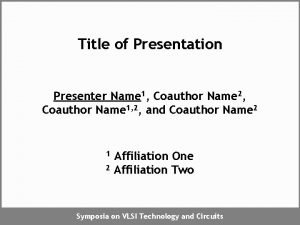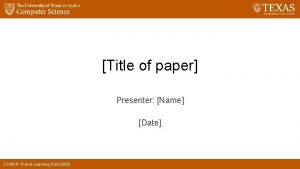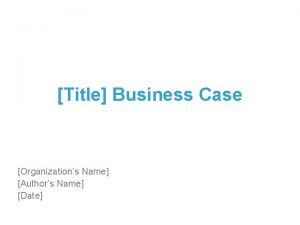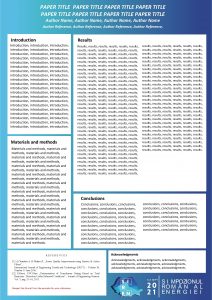Title of paper Presenter Name Date CS 391
![[Title of paper] Presenter: [Name] [Date] CS 391 R: Robot Learning (Fall 2020) [Title of paper] Presenter: [Name] [Date] CS 391 R: Robot Learning (Fall 2020)](https://slidetodoc.com/presentation_image/3e85d4b2ac7282ced66ec4cd5d941602/image-1.jpg)













- Slides: 14
![Title of paper Presenter Name Date CS 391 R Robot Learning Fall 2020 [Title of paper] Presenter: [Name] [Date] CS 391 R: Robot Learning (Fall 2020)](https://slidetodoc.com/presentation_image/3e85d4b2ac7282ced66ec4cd5d941602/image-1.jpg)
[Title of paper] Presenter: [Name] [Date] CS 391 R: Robot Learning (Fall 2020)

Motivation and Main Problem 1 -5 slides High-level description of problem being solved Why is the problem important? v v its significance towards general-purpose robot autonomy its potential application and societal impact of the problem Technical challenges arising from the problem v the role of the AI and machine learning in tackling this problem High-level idea of why prior approaches didn’t already solve Key insight(s) (try to do in 1 -3) of the proposed work CS 391 R: Robot Learning (Fall 2020) 2

Problem Setting 1 or more slides Problem formulation, key definitions and notations v Be precise -- should be as formal as in the paper CS 391 R: Robot Learning (Fall 2020) 3

Context / Related Work / Limitations of Prior Work 1 or more slides Which other papers have tried to tackle this problem or a related problem? v v The paper’s related work is a good start, but there may be others What is the key limitations of prior work(s)? CS 391 R: Robot Learning (Fall 2020) 4

Proposed Approach / Algorithm / Method 1 -5 slides Describe algorithm or framework (pseudocode and flowcharts can help) v v What is the optimization objective? What are the core technical innovations of the algorithm/framework? Implementation details should be left out here, but may be discussed later if its relevant for limitations / experiments CS 391 R: Robot Learning (Fall 2020) 5

Theory (if relevant) What are the assumptions made for theory? Are these reasonable? Realistic? If theory build strongly on other prior theory / results, reference those and state them here. CS 391 R: Robot Learning (Fall 2020) 6

Theory (if relevant, continued) State main results formally Give proof sketches Refer students to the full proofs in paper CS 391 R: Robot Learning (Fall 2020) 7

Experimental Setup 1 -3 slides Description of the experimental evaluation setting v v v What is the domain(s), e. g. , datasets, tasks, robot hardware setups? What are the baseline(s)? What scientific hypotheses are tested? How did the authors evaluate the success of their approach? v Clear description of the metrics that will be used CS 391 R: Robot Learning (Fall 2020) 8

Experimental Results >1 slide Present the quantitative and qualitative results Show figures / tables / plots / robot demos Pinpoint the most interesting / significant results CS 391 R: Robot Learning (Fall 2020) 9

Discussion of Results 1 -2 slides What conclusions are drawn from the results by the authors? v v What insights are gained from the experiments? What strengths and weaknesses of the proposed method are illustrated by the results? Are the stated conclusions fully backed by the results and references? v v If so, why? (Recap the relevant supporting evidences from the given results + refs) If not, what are the additional experiments / comparisons that can further support/repudiate the conclusions of the paper? CS 391 R: Robot Learning (Fall 2020) 10

Critique / Limitations / Open Issues 1 -2 slides What are the key limitations of the proposed approach / ideas? (e. g. does it require strong assumptions that are unlikely to be practical? Computationally expensive? Require a lot of data? ) Are there any practical challenges in deploying the approach on physical robots in the real world? Are there any safety or ethical concerns of using such approach? If follow-up work has addressed some of these limitations, include pointers to that. But don’t limit your discussion only to the problems / limitations that have already been addressed. CS 391 R: Robot Learning (Fall 2020) 11

Future Work for Paper / Reading 1 -2 slides What interesting questions does it raise for future work? v v Your own ideas for future work Others’ ideas (if others have already built on this idea) CS 391 R: Robot Learning (Fall 2020) 12

Extended Readings 1 -2 slides Pointers to papers that use this paper as a reference and/or other very related papers that others may want to read Point classmates to where they can go for further reading on this paper/reading CS 391 R: Robot Learning (Fall 2020) 13

Summary 1 slide Approximately one bullet for each of the following v v v Problem the reading is discussing Why is it important and hard What is the key limitation of prior work What is the key insight(s) (try to do in 1 -3) of the proposed work What did they demonstrate by this insight? (tighter theoretical bounds, state of the art performance on X, etc) CS 391 R: Robot Learning (Fall 2020) 14



























